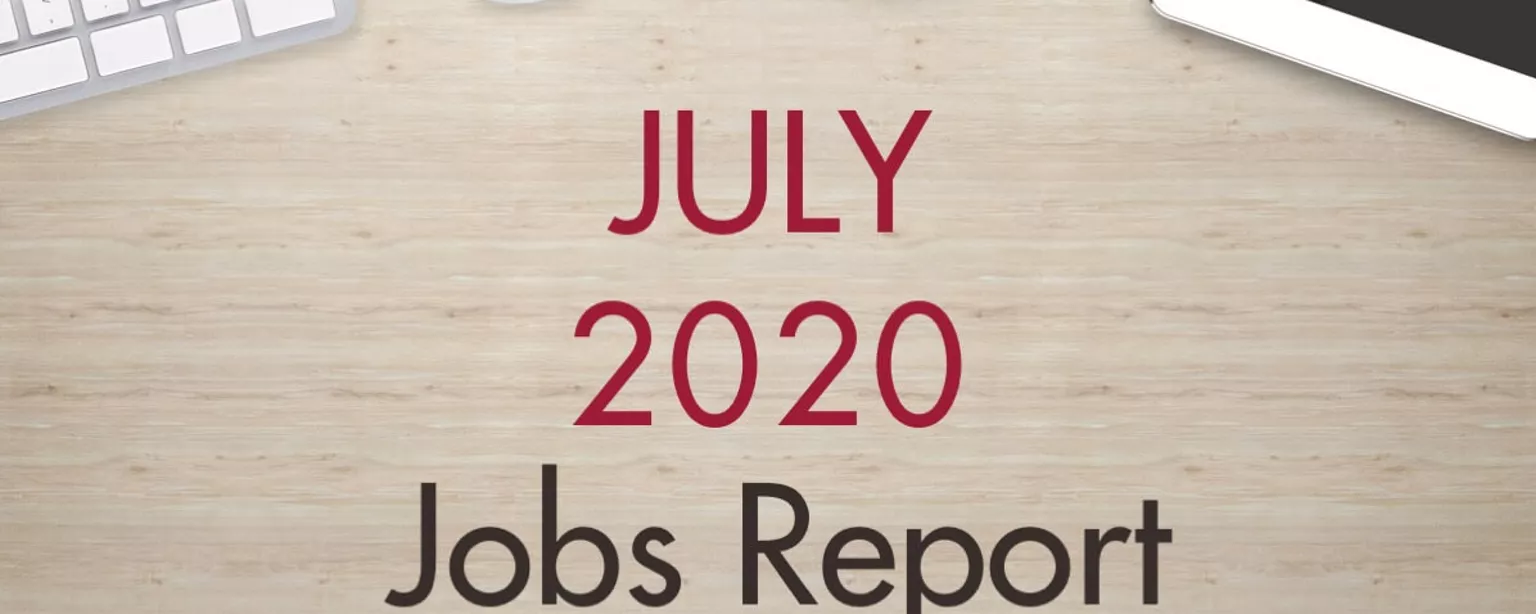The economy saw job gains of 1.8 million in July, as the labor market continues to recover from the disruption caused by the COVID-19 pandemic and efforts to contain it.
Employers in the leisure and hospitality industry expanded payrolls the most last month, adding 592,000 jobs. Other sectors that saw employment rise significantly in July include:
- Government: 301,000 jobs added
- Retail trade: 258,000 jobs added
- Education and health services: 215,000 jobs added
- Professional and business services: 170,000 jobs added
- Other services: 149,000 jobs added
The BLS also reported that job gains for May and June combined were higher than previously reported, by 17,000 jobs.
Unemployment rate edges down to 10.2%
The BLS reported that the national unemployment rate slipped to 10.2% in July. It was 11.1% in June.
The unemployment rate for college-degreed workers who are 25 or older — the professionals most highly sought-after by employers — also declined slightly last month. The rate in July was 6.7%, down from 6.9% in June.
What employers need to know
The COVID-19 crisis has made flexible work schedules a must for many employees — and, in most cases, it’s benefiting employers. In a Robert Half survey, 79% of professionals said their job currently allows for windowed work, or the ability to break up the day into distinct chunks of business and personal time. Of those respondents, 73% reported that the arrangement has enhanced their productivity.
How can you make windowed work and other flexible work schedules successful for your business and employees for the long term? Here are some quick tips:
Make it a formal program
Your team may have shifted to windowed work out of necessity. But as things continue to normalize, take the opportunity to create a more organized process. You can define expectations and determine how you’ll track and measure the program’s success.
Emphasize calendar upkeep
Staff members engaging in windowed work need to keep their colleagues (and you) in the loop about their availability to meet and collaborate during the workday. Online scheduling tools can help make it easy for teams to keep calendars up to date.
Increase communication
Meet regularly with employees who are working flexible schedules to ensure they’re keeping their projects on track and staying on top of deadlines. (No doubt you’re already doing this if you’re managing a remote team.)
Giving employees more control over their schedules for the long term also sends a clear message that the company trusts them to make good decisions. And by showing that you’re committed to helping employees maintain work-life balance, you can keep morale up and boost retention.
What job seekers need to know
Trying to balance work or job-search activities with personal demands is stress-inducing under normal circumstances, let alone during a pandemic. If you were thrust into a remote work situation abruptly, you may still be trying to get your bearings. And if you’re looking for work, the uncertainty that can accompany not having a job can make you feel even more anxious.
So, what can you do to keep your outlook positive and stress in check in this unprecedented time? Here are two strategies that might help:
Choose a designated workspace
Whether you’re working or job searching or both, carve out a space in your home that is specifically for those activities. Even if your living space is small, it’s still important to find your own spot where you can be productive. You can also set the expectation with others in your household that you should not be disturbed while in your space.
Create a routine
A routine can help keep you moored while working remotely or add more structure to your day if you’re unemployed. Many professionals have turned to windowed work during the pandemic, which you may also find useful. A windowed workday might look like this:
- 7 – 9 a.m.: Breakfast and childcare
- 9 a.m. – 12 p.m.: Collaborative teamwork and meetings or job-search activities
- 12 – 1 p.m.: Independent work or professional development
- 1 – 2 p.m.: Lunch and exercise or meditation
- 2 – 3 p.m.: Errands
- 3 – 5 p.m.: Collaborative teamwork and meetings or job-search activities
- 5 – 7 p.m.: Dinner and child care
- 7 – 9 p.m.: Independent work or job-search activities and professional development
Finding space and bringing order to your day can help you manage your stress — and time — more effectively.
JULY 2020 U.S. BUREAU OF LABOR STATISTICS MONTHLY JOBS SUMMARY
1,763,000 JOBS ADDED*
10.2% UNEMPLOYMENT RATE*
6.7% UNEMPLOYMENT RATE UNEMPLOYMENT RATE FOR COLLEGE GRADS*/**
UNEMPLOYMENT RATE OVER THE PAST 12 MONTHS*
| Unemployment Rate | Unemployment Rate for College Grads | ||
|---|---|---|---|
| August '19 | 3.7% | 2.1% | |
| September '19 | 3.5% | 2.0% | |
| October '19 | 3.6% | 2.1% | |
| November '19 | 3.5% | 2.0% | |
| December '19 | 3.5% | 1.9% | |
| January '20 | 3.6% | 2.0% | |
| February '20 | 3.5% | 1.9% | |
| March '20 | 4.4% | 2.5% | |
| April '20 | 14.7% | 8.4% | |
| May '20 | 13.3% | 7.4% | |
| June '20 | 11.1% | 6.9% | |
| July '20 | 10.2% | 6.7% |
*Source: Bureau of Labor Statistics
**College-degreed workers 25 and older
See what these results mean for job seekers and employers at roberthalf.com/blog.
WORKPLACE RIVALRIES ON THE RISE
28% of workers said the level of competition among employees at their company is higher than a year ago.
Source: Robert Half survey of more than 2,800 workers in the U.S.
© 2020 Robert Half. An Equal Opportunity Employer M/F/Disability/Veterans.
roberthalf.com








